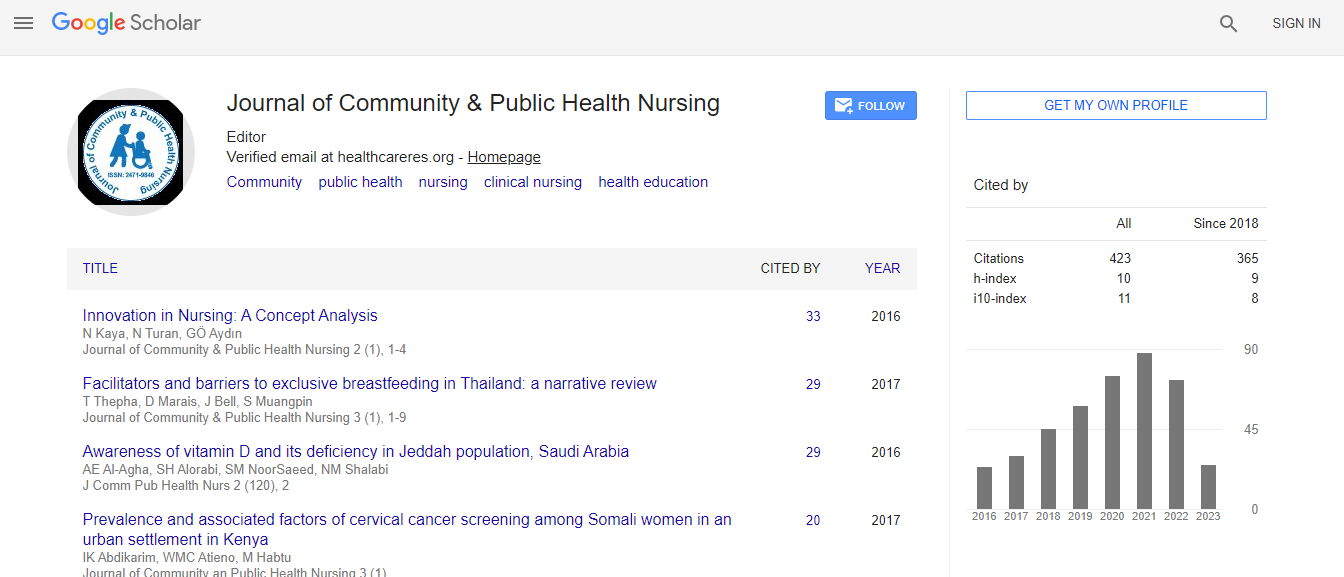Our Group organises 3000+ Global Conferenceseries Events every year across USA, Europe & Asia with support from 1000 more scientific Societies and Publishes 700+ Open Access Journals which contains over 50000 eminent personalities, reputed scientists as editorial board members.
Open Access Journals gaining more Readers and Citations
700 Journals and 15,000,000 Readers Each Journal is getting 25,000+ Readers
Google Scholar citation report
Citations : 739
Journal of Community & Public Health Nursing received 739 citations as per Google Scholar report
Journal of Community & Public Health Nursing peer review process verified at publons
Indexed In
- Google Scholar
- CiteFactor
- RefSeek
- Hamdard University
- EBSCO A-Z
- OCLC- WorldCat
- Publons
- Geneva Foundation for Medical Education and Research
- ICMJE
Useful Links
Recommended Journals
Related Subjects
Share This Page
New tools for pediatric nursing; discovering health consequences of cultural attitudes about lead and its association with contaminated children�s play areas in oslo, norway and new orleans, usa.
4th World Nursing Congress
Howard W. Mielke
Department of Pharmacology, Tulane University School of Medicine, USA
Keynote: J Comm Pub Health Nurs
Abstract
Introduction: Lead is an extreme toxicant. This study applies new instruments to find and map health relevant lead in parks and childcare areas where children play. Oslo, Norway and New Orleans, USA are similarly sized cities, and provide play areas for children. The median soil lead in Oslo play areas is 25 mg/kg vs. 418 mg/kg in New Orleans play areas. Why are median play areas in Oslo 17 times lower than play areas in New Orleans? The cultural attitudes toward two commercial lead products, lead-based paints and Pb additives in gasoline, provide cause for the unusual differences in soil lead at children�s play areas of these two cities. In Norway lead-based paint was banned during the 1920s, and the US, lead-based paint contained 1%-50% Pb until regulated downward in 1978. In Norway public transportation was subsidized, and automobile use was discouraged and fuel was highly taxed. In the US, public transportation dawdled, and automobile use was encouraged; leaded gasoline subsidized. The outcome of the cultural differences in attitudes about household and transportation uses of lead resulted in environmental and exposure disparities. The consequences to life expectancy, learning, behavior, and all organ systems are known when children are excessively exposed to lead. Children living in the two cities demonstrate differences that align with what is known about lead exposure. From the pediatric nursing and whole-of-society perspective, the fundamental lesson is that if Pb exposure is prevented in the first place then the outcomes is life-long health benefits for individuals and the whole society.Biography
Howard Mielke is in the Department of Pharmacology, Tulane University School of Medicine, New Orleans. He received his MS and PhD from the University of Michigan. He established the application of analytical instruments to urban soil metal research. His pioneering research in Baltimore soils and blood lead and soil studies in Minnesota resulted in testimony to ban lead additives in gasoline. He assisted Norway with their National Clean Soil Program, studied lead acetate in cosmetic products that spurred its elimination, and demonstrated the effectiveness of low-lead soil in remediating contaminated inner-cities. His goal is primary prevention and improving urban environments.

 Spanish
Spanish  Chinese
Chinese  Russian
Russian  German
German  French
French  Japanese
Japanese  Portuguese
Portuguese  Hindi
Hindi 
